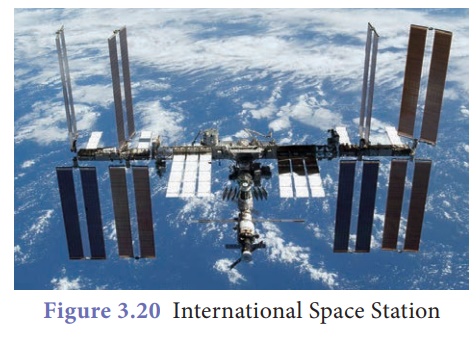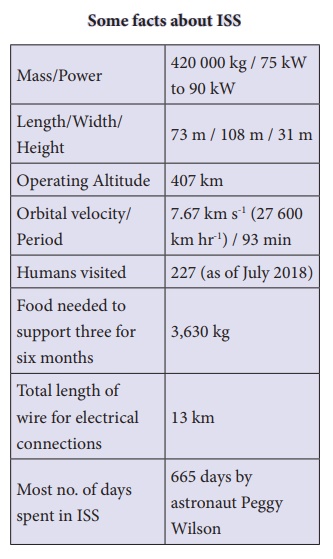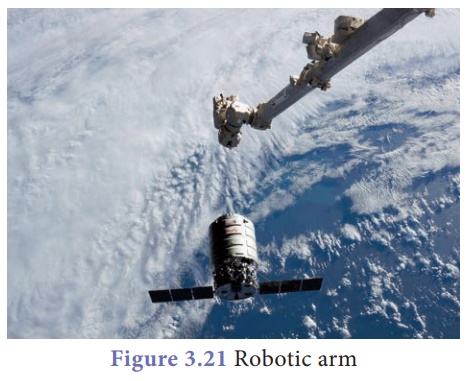Universe - International Space Station | 9th Science : Universe
Chapter: 9th Science : Universe
International Space Station
International Space Station
ISS is a large
spacecraft which can house astronauts. It goes around in low Earth orbit at
approximately 400 km distance. It is also a science laboratory. Its very first
part was placed in orbit in 1998 and its core construction was completed by
2011. It is the largest man-made object in space which can also be seen from
the Earth through the naked eye. The first human crew went to the ISS in 2000.
Ever since that, it has never been unoccupied by humans. At any given instant,
at least six humans will be present in the ISS. According to the current plan
ISS will be operated until 2024, with a possible extension until 2028. After
that, it could be deorbited, or recycled for future space stations.

1. Purpose of International Space Station
The ISS is intended to
act as a scientific laboratory and observatory. Its main purpose is to provide
an international lab for conducting experiments in space, as the space
environment is nearly impossible to reproduce here on Earth. The microgravity
environment present in the ISS provides ideal conditions for doing many
scientific researches especially in biology, human biology, physics, astronomy
and meteorology.

2. Benefits of ISS
According to NASA, the following
are some of the ways in which the ISS is already benefitting us or will benefit
us in the future.
Supporting water-purification efforts
Using the technology
developed for the ISS, areas having water scarcity can gain access to advanced
water filtration and purification systems. This could very well be a
life-saving difference for the people in such hazardous locations. The water
recovery system (WRS) and the oxygen generation system (OGS) developed for the
ISS have already saved a village in Iraq from being deserted due to lack of
clean water.
Eye tracking technology
The Eye Tracking Device,
built for a microgravity experiment, has proved ideal to be used in many laser
surgeries. This device tracks the eye’s position very accurately without
interfering with the surgeon’s work. Also, eye tracking technology is helping
disabled people with limited movement and speech. For example, a kid who has
severe disability in body movements can use his eye-movements alone and do
routine tasks and lead an independent life.
Robotic arms and surgeries
Robotic arms developed
for research in the ISS are providing significant help to the surgeons in
removing inoperable tumours (e.g., brain tumours) and taking biopsies with
great accuracies. The same technology designed for huge robotic arms that help
astronauts in space is being brought back to Earth to do some heavy lifting in
cancer treatment - in the form of a surgical robot. Its inventors say that the
robot could take biopsies with remarkable precision and consistency.

Apart from the
above-mentioned applications there are many other ways in which the researches
that take place in the ISS are helpful. They are: development of improved
vaccines, breast cancer detection and treatment, ultrasound machines for remote
regions etc,.
3. ISS and international  cooperation
As great as the ISS’
scientific achievements are, no less in accomplishment is the international
co-operation which resulted in the construction of the ISS. An international
collaboration of five different space agencies of 16 countries provides,
maintains and operates the ISS. They are: NASA (USA), Roskosmos (Russia), ESA
(Europe), JAXA (Japan) and CSA (Cananda). Belgium, Brazil, Denmark, France,
Germany, Italy, Holland, Norway, Spain, Sweden, Switzerland and the UK are also
part of the consortium. In fact, in the late 1950s, the idea of international
space missions was unthinkable. The first part of the ISS was launched by the
Russian Zarya module, which was funded by America. The first crew sailed on
board was Russian Soyuz spaceship. Even as the ISS has sections split into US
Orbital Segment, Russian Orbital Segment etc., on the whole it is jointly-owned
by all the participating agencies and their nations. Cooperative international
agreements between the world powers have made the largest international
scientific undertaking a possibility. The many significant researches and
functions of the ISS could only have been possible with the full co-operation
of these nations.
Related Topics